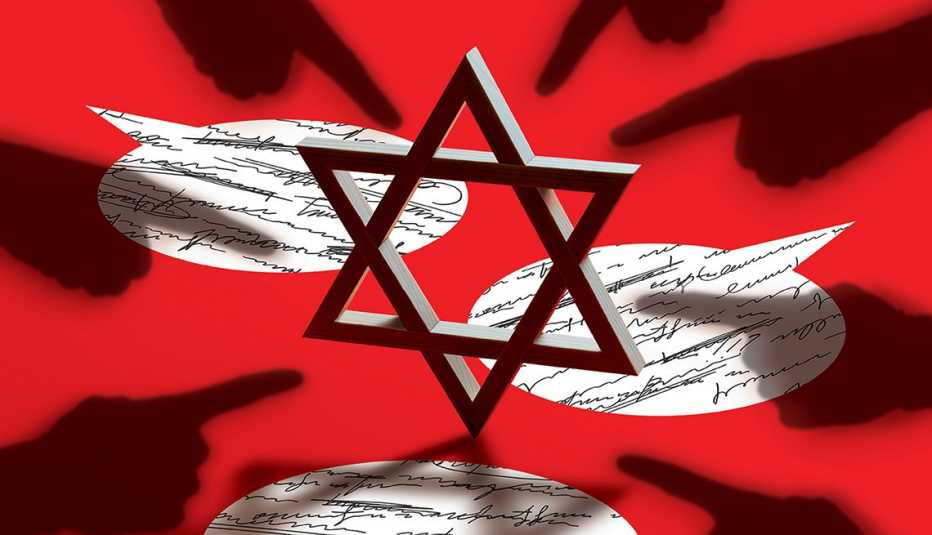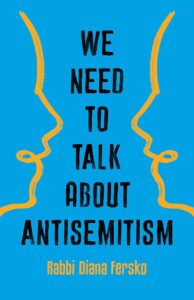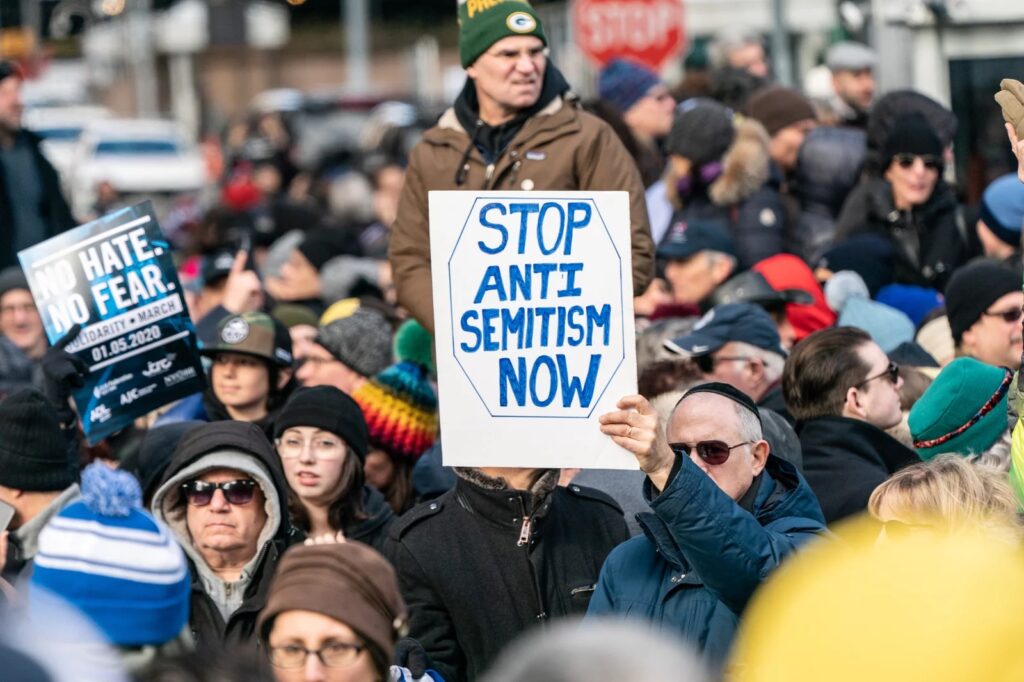Jew Hatred in the 21st Century
A review of “We Need to Talk about Antisemitism”

(Image creator and source: Doug Chayka for AARP)
Rosh Hashanah services in New York, New Jersey, and California were disrupted this year by bomb threats. Donald Trump’s Jewish New Year message accused liberal Jews of destroying America and Israel. And Elon Musk produced an antisemitic dog whistle by suggesting that George Soros and company were out to destroy Western civilization. This news cycle formed the background noise to my reading of Rabbi Diana Fersko’s We Need to Talk About Antisemitism, which is to say that her book could hardly be more timely.
Fersko is the senior rabbi at the Village Temple in Manhattan, and New Yorker readers might remember that she took to the streets of her neighborhood during the pandemic to forge community. As the introduction to We Need to Talk About Antisemitism makes clear, even in a city with a critical mass of Jews, she and her congregation have not been immune to the contemporary surge of anti-Jewish hate crimes. In June 2021, she arrived at her synagogue to find its glass door shattered; a baseball bat was the weapon of choice in this crime that evoked the specter of Kristallnacht, the 1938 night of broken glass at Jewish institutions, businesses, and homes in Germany. “Can anyone really recover from seeing their house of worship desecrated?” is the question that sets the stage for her call to action on the antisemitism that, almost unbelievably, plagues the 21st Century.
Explanations for antisemitism’s persistence abound, and Fersko addresses several in her book. One is that antisemitism is a contagious virus, a neat reversal of the antisemitic canard that Jews are the purveyors of illness. Another is that antisemitism pits Jews against the “highest values of any given society,” which helps to explain historical changes in antisemitic ideas. When Christianity reigns supreme, Jews are cast as Christ-killers; when human rights take center stage, “the Jewish state is labeled as the single most heinous violator” of those rights. Ultimately, Fersko favors the theory that not talking about antisemitism enables its survival. This, of course, drives her focus on not only insisting that we talk about antisemitism but also shifting HOW we talk about it.
 Fersko identifies the “political left” as her “own community,” and one of her aims is to call out that part of her chosen family’s contributions to antisemitic discourse. Although she is careful not to conflate lefty antisemitism with the “violence committed by white supremacists,” she nevertheless insists that “antisemitism needs to be named and shamed wherever it exists, even when it’s hard to do so. Sometimes we avoid talking about antisemitism because it comes from our neighbors, friends, colleagues, and schools. Sometimes we avoid talking about antisemitism because it’s way too close to home.”
Fersko identifies the “political left” as her “own community,” and one of her aims is to call out that part of her chosen family’s contributions to antisemitic discourse. Although she is careful not to conflate lefty antisemitism with the “violence committed by white supremacists,” she nevertheless insists that “antisemitism needs to be named and shamed wherever it exists, even when it’s hard to do so. Sometimes we avoid talking about antisemitism because it comes from our neighbors, friends, colleagues, and schools. Sometimes we avoid talking about antisemitism because it’s way too close to home.”
To illuminate contemporary antisemitism, Fersko adroitly weds the left’s concept of microaggressions to the foundational story of Exodus. In Exodus, Egypt is known as Mitzrayim, the “narrow place.” Antisemitic microaggressions narrow Jewish possibilities for being in the world:
“Small but persistent insults bring us closer to that narrow place. They diminish Jewish identity into something put upon us by others. They stuff us back into that restrictive existence. Narrowing is an attempt, albeit often an unwitting one, to constrict the diversity that runs wild through the Jewish people. Narrowing shrinks our Jewish identity into a basic box of prepackaged American ideas. It denies the breadth and nuance of Jewishness. It ignores our history. When the Jewish people are narrowed, we tend to feel less comfortable in mainstream culture. This process increases incrementally until we don’t feel we can be outwardly Jewish at all.”
The supposed compliment that someone looks “Jewish but, you know, pretty” depends on stereotypical assumptions that put Jewishness at odds with physical attractiveness and robs the community of its physical diversity. The “soft antisemitism” of humor often narrows Jews into a cheap, whiny people. And if the mass media primarily tells stories about the dead Jews of the Holocaust or those who escape from the supposed horrors of Orthodox Judaism, then we drastically limit cultural ideas about Jews today. Such narrow ideas about Jewish looks, lives, and behavior ultimately encourage Jews to commit microaggressions against themselves and other Jews.
For Fersko, when it comes to racial talk about Jews, microaggressions quickly turn into macroaggressions. She rightly points out that the White Jew is often a caricatured figure who represents the “epitome of whiteness and everything terrible about it.” Flyers on a college campus that read “Ending White Privilege Starts With Ending Jewish Privilege” exemplify this tendency. Even as she decries such antisemitic figuring of the White Jew, she strives to do anti-racist work and to promote alliance politics. Writes Fersko, “I do want to acknowledge that I have the advantages of whiteness based on my appearance,” and “rather than fomenting tension between Black and Jewish communities, we should fight the twin hate of antisemitism and racism together.”
At one point, however, Fersko insists that “many of us don’t feel white,” as if individual feelings are the arbiter of racial positioning in an admittedly complex U.S. racial hierarchy. Similarly, her explanation for titling a section of the race chapter “Black Extremism” seems misguided at best:
“I’ve chosen to label this section with the term Black extremism to remind us all that these ideas are by definition extreme—they do not represent the mainstream of the Black community by any means. And they should not be confused with a discussion of Jews who are Black. Instead, this perverse ideology is upheld by fringe groups like the Radical Hebrew Israelites and the Nation of Islam.”
Separating out the good Black people from the bad Black people isn’t an act of alliance politics (and Jews who are routinely asked to pass a litmus test on Israel should know this). Viewing “extreme” Black people as uber-antisemites is no more salutary than viewing White Jews as uber-white supremacists. Rather, we need to recognize that antisemitism and anti-Black racism are in the air that we all breathe, no matter our identity.
Given that the charge of “Black extremism” has traditionally been used to short circuit racial justice movements, this rhetorical choice undercuts anti-racist commitments. While Fersko mentions Black Jews several times in this discussion, she does not include their writings or perspectives on being at the intersection of antisemitism and anti-Black racism. For example, when she mentions Jewish institutions fostering relationships with law enforcement to combat antisemitism, she does not recognize the specific and complex security needs of Jews of color in a racist state. Synagogues that racially profile Black Jews may be secure but remain narrow places.
Predictably but compellingly, Fersko insists that talking about antisemitism means that we have to talk about the Holocaust and Israel. Although there’s lots of Holocaust talk in contemporary culture, most of it is in the form of memes and metaphor. We use the Holocaust to talk about school shootings, vaccine mandates, or abortion. Such use means that the Shoah “is no longer presented as a tragedy in its own right. Now it’s a vehicle for someone else’s cause. A path to something else.” This “Flat Holocaust” de-Jews the Shoah, paves the path for Holocaust denial, and results in a millennial generation that is historically illiterate. To combat such illiteracy, Fersko offers “Fela’s Story,” a survivor testimony, at the end of the book; reading about the “actual Holocaust” and what Fela “witnessed and endured” can begin the “fight against the flattening of the Holocaust.”
The relationship between antisemitism and Israel/Zionism is vexed and complex. Discussions of this relationship are acrimonious (how’s that for understatement!), and Fersko is acutely aware that she is taking on an “unwinnable task.” Despite such trepidations, she forges ahead in making the argument that “anti-Israel antisemitism is the socially acceptable Jew hate of our day, the antisemitism en vogue, the antisemitism that feels right, necessary even for some people, especially in my beloved liberal world.” Anti-Zionist discourse frequently makes Jews suspect in progressive spaces, even when the issues at hand are not Israel-related. When a professor will only write a recommendation for students whose position on Israel passes muster, or when “annual apartheid week” imagery promotes such classic antisemitic ideas as the blood libel, then the way we talk about Israel narrows political and educational possibilities for American Jews.

(Rally on January 5, 2020 to bring attention to rising antisemitism. Image source: Jeenah Moon for Getty Images)
Following Hamas’s massacre of Israelis in October, social media was a bracing place to be, and Fersko’s argument seemed to be gathering evidence post by post. Many leftist academics, in particular, seemed at pains to ignore Hamas’s human rights crimes against Israeli Jews; instead, they chose to focus on the provocation of occupation and the necessity of decolonization.
Fersko not only names anti-Zionism as a contemporary form of antisemitism but also admits her worries about doing so. Such forthrightness about her own Jewish journey and sensibility is present throughout the pages of this explanatory and activist text. When discussing the tendency of Jews to “narrow their own identity,” she recalls the ways in which she “creat[ed] a separation between my secular self and my Jewish one.” For example, she learned not to share with friends her family’s lovely tradition of celebrating “’Erev Birthday’—beginning a birthday celebration the night before the day of birth—to keep the custom of Jewish holidays beginning at night.” In Antisemitism: Here and Now, historian Deborah Lipstadt urges Jews not to inadvertently reduce Jewish identity to the experience of Jew hatred; Lipstadt’s marvelous formulation is that we need to focus on Jewish joy as much as the “oy.” Fersko’s stories of hiding erev birthdays or struggling to imagine joining in when a child sings a Hebrew song on the subway rather than admonishing that child to tone down her Jewishness, certainly illustrate the losses Jews sustain from antisemitism. However, those stories also reveal the joys to be had by actively naming and resisting this particular “ism.”
The clear guidelines Fersko provides for changing the conversation and thus the climate for American Jews is a much-needed breath of fresh air. She insists that we name antisemitism, that we refrain from tokenizing some Jews over others, and that we shun “groupthink.” Rather than using Jews in “American power struggles,” we need to allow a diversity of Jewish expression and celebrate Jewish life. These conditions are necessary for American Jews to continue to flourish in the United States. Not coincidentally, these conditions are also aligned with a healthy democracy that respects the separation of church and state.
We Need to Talk About Antisemitism is likely to fuel not only talk and action but also disagreement. In 2023, such wrestling with antisemitism is necessary work for Jews and non-Jews alike.
Helene Meyers is Professor Emerita of English at Southwestern University. Her most recent book is Movie-Made Jews: An American Tradition.